Second Season: Podcast Episode #8
Introduction to Series 2
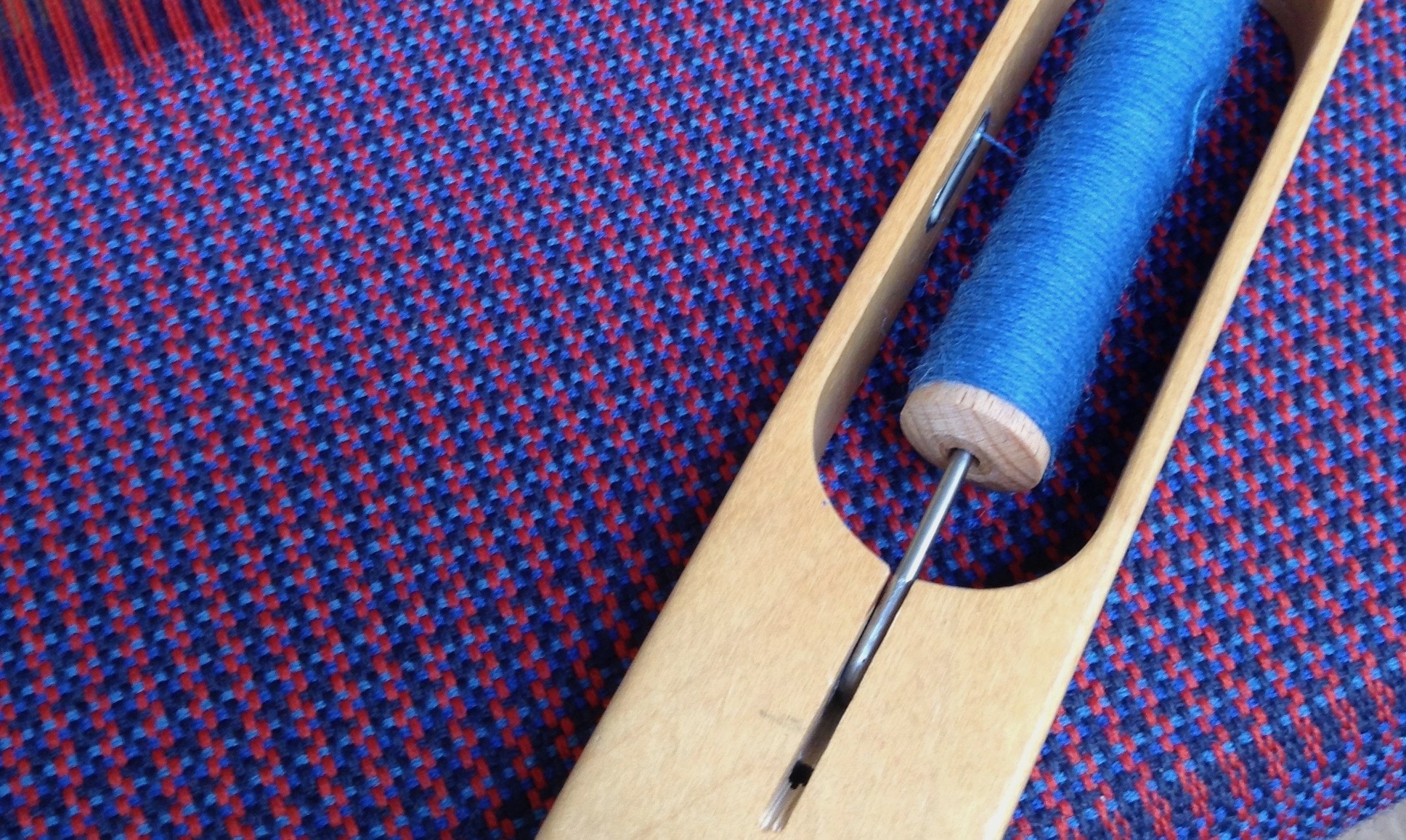
Why does touch matter so much to us? What is the connection between cloth and our emotions? This new season of Haptic and Hue’s Tales of Textiles explores how we express ourselves through cloth, whether it’s the comfort quilts and blankets bring us, the way we use clothes to take the burden of losing someone we love, or why certain patterns and fabrics connect us strongly with memories of childhood, school or first love.
Each episode takes a different feeling and unravels what it means to us in textiles. The series is narrated by Jo Andrews a handweaver and broadcaster. In this season we travel around the world, from Alabama to India, Tokyo to the London Underground and Ghana to North East Scotland thinking about different traditions of making and using fabric.
I provide a full transcript, pictures and links to the work of the contributors to these podcasts, as well as a list of books and articles that have inspired me on my website at: www.hapticandhue.com/listen.
If you would like to sign up for your own link to the podcasts as they are released, for extra information and a chance to access the free textile gifts that I’ll be offering for each podcast in this series then please fill out the very brief form here or find it on the Haptic and Hue Listen page.
If you are interested in a long read or two, or want to know why and how cloth speaks to us then you can find articles at www.hapticandhue.com/read
You can follow Haptic and Hue on Instagram @hapticandhue on Facebook or Linked In under the Haptic and Hue name. You can see more of my work and that of other makers there or on the website.

Claire Wellesley Smith
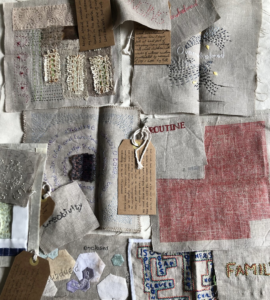
One of Claire’s cloths
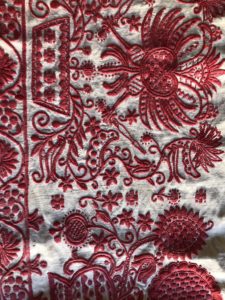
A story cloth – Claire Wellesley Smith
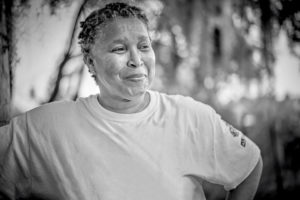
Loretta Bennett

Quilt of old jeans Loretta Bennett
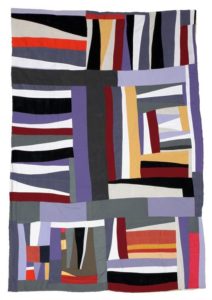
Gees Bend Design

Alessandro Nivola
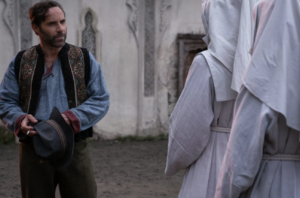
Alessandro Nivola as Mr Dean
Black Narcissus
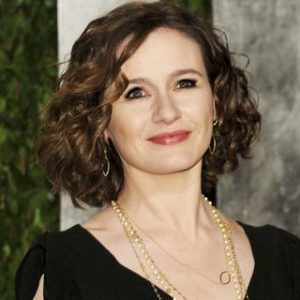
Emily Mortimer
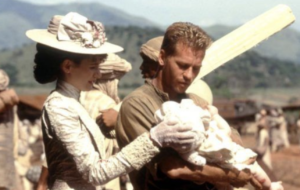
Emily Mortimer, full costume
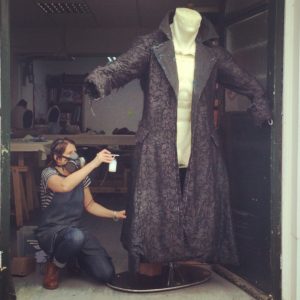
Jo Weaving, Breakdown Artist
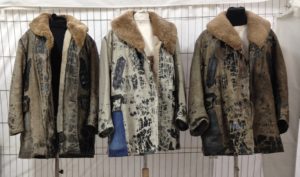
Aging a coat for Jason Moma
Script of Podcast
The three Fates have had many faces and names down the long centuries of human history. Sadly, knowledge of them is fading. But once people were familiar with them and believed them to be all powerful– as goddesses should be, because they controlled the mother thread of life and every mortal or divine being submitted to them.
In Greek mythology, to give them just one set of the names they have had, Clotho spun the thread of life on her spindle, Lachesis measured the length of each person’s life span. And Atropos had the task of cutting the thread with her shears, deciding when each life ended.
The ancient writers said that Lachesis sings the things that were, Clotho the things that are, and Atropos the things that are to be. I have always wondered which of the three is the most powerful and have come to the view that they are dependent on each other, each has her own function and together they are formidable.
I have found their presence comforting this last year. The thought that they are taking responsibility for each of us, considering each of us, gives us a way to accept the things we cannot control. It is also interesting that in so many different cultures cloth has been seen as the fabric of life, and a way to understand the unknown.
Welcome to the second series of Haptic and Hue’s Tales of Textiles. I’m Jo Andrews, I’m a handweaver interested in how cloth speaks to us and the impact it has on our lives. So many of the stories that shape our world are untold. Like a mudlark’s treasures, they lie buried on the shore of a great river, but they need to be dug out, carefully washed, and examined for us to understand how they contribute to who we are and what we value. That’s what this series of podcasts tries to do with fabric and textiles of all kinds.
Many words in our languages come to us from textiles and fabric making, it was a central occupation of our societies as the family of languages formed and branched from each other. The word Feeling is an interesting one. It comes to us from the Old English word Felan, which meant the act or sense of touch, something people who live with and engage with textiles think about more than most. Until about a thousand years ago that’s all it meant, but then like lots of good words it began to change shape. It became a word that as well as meaning touch, also became a way to talk about our emotions – our feelings.
It’s not just English in which the word made the same journey, it’s also in Dutch where the word Voelen has the same dual meaning, and in German where you talk about Fuhlen.
I count it as one of the many useful things a knowledge of cloth and its processes has gifted us. But in this series of Tales of Textiles what I want to do is to try to return the favour and use words that express our feelings to think about different practices and skills in making and mending textiles.
I have always thought that there is a close connection between touch, and emotions or feelings, one that goes back to before the written word. Many of us know this instinctively. A Dutch woman, now well into her eighties who looked after me and my siblings when we were very young, says that the minute she picks up a needle and thread, her troubles fly away. I know spinners who say they spin away their worries, knitters who use that skill to tackle depression, and weavers who lose themselves in the meditative movement of throwing the shuttle.
But it goes further than that: the connection between textiles and emotions runs very deep and in this series that’s what I want to explore, whether it’s the comfort quilts and blankets bring us, the way we use clothes to take the burden of losing someone we love, the emblems we conjure to express identity and power, or why certain patterns and fabrics connect us powerfully with memories of childhood, school or a first love
Each of the episodes in this series is called after a feeling, from which a story spins out. This is not the definitive story of what that feeling means in terms of textiles, it’s just an attempt to unravel some threads a little.
I like to think about, textiles as, as small storytelling objects that can really, um, you can really unpack a story from the layers., and so that those layers might be just layers of wear but when you get a Garment or a textile object, that’s been patched, reinforced, repaired, I’m thinking about, you know, the craft of use, the time and the life that’s held in those objects. And I suppose that that gives them great resonance really, for communication, and for comfort, that, that could hold a lot
That’s Claire Wellesley Smith, who works with community groups in West Yorkshire in Britain and uses textiles to help people unpick family stories and histories.
I think we could learn so much from really ordinary objects and, I suppose that the ordinary thing can, can become quite extraordinary through, its lifecycle. And so I suppose I’m always interested in, in, in that. And one of the things that, um, uh, I’ve really enjoyed doing with, with groups in my working life is, is, is asking people to bring things in, that normally they wouldn’t talk about. So we’re challenged, for example, to find the oldest garment in your wardrobe that you still actually wear and, and tell the story of that. And, you get extraordinary details and stories about, a dress or a coat, um, that, you know, takes somebody sometimes through 20, 30, 40 years of their life. And so I suppose, I’m looking for the story, in the object or the garment, and I find that endlessly fascinating.
One of the tales we will be exploring is the story of the community of textile artists from Gees Bend in Alabama. In this small isolated village, without access to anything much, generations of women have designed and made quilts that a New York art critic once said was ‘equivalent to anything produced by Klee or Matisse”
One of those artists is Loretta Pettway Bennett who often uses old clothes in her original work as a way of maintaining a connection with her ancestors.
So, and I just, you know, I kind of go back to the time when they, my parents, my great, great grandparents when they were making quilts, you know, using what they had, even though I can afford to buy, you know, stuff these days, but I like to use old pants and, and shirts, and it’s kind of a way of me getting in, even been back in touch. I kind of feel like I am, I don’t know how you would say it. I kind of feel like they are with me when I’m, when I’m doing, you know, my sewing, my quilts, and stuff. I can, I can feel like they are there with me.
And that’s a lovely feeling to be able to access. Something that is unspoken but gives you a doorway to memories of the people you loved.
In a different sense, it’s something that actors are constantly striving to find, the doorway through which they can pass to transform themselves into someone else. Alessandro Nivola plays Mr. Dean in the recent BBC show, Black Narcissus, and has a major role in The Many Saints of Newark – a prequel to the Sopranos which will be released later this year.
I tend to probably more often than not start with those kinds of visual cues and you know, often one of the first things that I’ll do when thinking about a character is try and find images, of what that person in might look like in the real world and those visual images, are, you know, are what end up, sparking my imagination off. And soI would say it’s just a huge, huge part of, of character because I think that the way that people dress affects the way that they are physically the way that they move. And it’s always a very strong reflection of a lot of things that are going on psychologically with the character. So, um, it, it really is a very high priority for me.
Alessandro’s wife is the wonderful Emily Mortimer, who has been in many productions familiar to audiences around the world including Notting Hill, Mary Poppins, The Bookshop. She has a new BBC series out later this year, Nancy Mitford’s The Pursuit of Love in which she both acts and Directs.
Yes, it just totally does shapeshift you when it’s the right costume and you feel that everything’s working in unison with it. It makes you walk a different way and it makes you talk a different way and move a different way and behave a different way when it’s right. And when it’s not right, it’s awful, when it’s right, you don’t have to think about it. You’re just, you’re just being helped to step into this new person’s skin. And everything becomes easier, but when it’s not right, everything becomes harder and you’re battling against it and you aware of it and you’re worrying about it.
But it’s the people behind the final on-screen performance that intrigues me, the production designers, the costume designer, and the breakdown artists who have the wonderful job of weathering the costumes so that they look the part:
Well, we are a department now that works alongside the costume design team. And basically, if a garment was seen brand new, straight from the makers or brand new, straight from the shops, it just wouldn’t look believable. And so we give it the believability. So we make the costume looked like the person or the character owns it. So whether it’s been in the obvious situation, like in a battle or whether it’s work where then obviously you’ve got heavier breakdown on it, but everything down to just your favorite jumper or a pair of jeans that you have worn a few times, we make it look realistic. And so we give it a bit of life and a bit of history and just make it look like the character belongs in it. Otherwise everything would look brand new.
That’s Jo Weaving, Breakdown Artist to the stars in the episode where we explore a feeling of transformation. The series will also be looking at nostalgia, belonging, pain, sorrow, comfort, revival, and joy.
And there is nothing that says joy to me more than the sounds of a lambing shed as the cycle of life turns over again.
Part of the point of Haptic and Hue is to lift the curtain on cultures and thoughts other than our own. I know none of us has been able to do a whole lot of travelling this past year, but with this series of Tales of Textiles, we will at least hear from people around the world, from Cumbria to Ghana, Alabama to Tokyo, Bengal to the northeast of Scotland.
Each episode may not be how you think about that feeling at all, but I hope it helps prompt new associations for you either in your own making or in the way in which you perceive your own emotions and or those of others.
This series of Haptic and Hue’s Tales of Textiles would not have happened without you, the listeners and writers of reviews. Thank you for all your support and encouragement, it has meant a great deal and given me the confidence to make more episodes.
I have enjoyed all the reviews, but one, in particular, struck a note with me. It comes from Kimmiotta in the US:
I cannot recommend this Podcast enough to people interested in fiber arts. It is so interesting. I’ve listened to a couple of episodes twice to make sure I didn’t miss any details. My five-year-old son doesn’t complain if this is on in the car. It’s the only Podcast I like that he’ll tolerate.
I salute the five-year-old boy who is prepared to listen and am hoping for a whole lot more listeners just like you.
This episode of Haptic and Hue was narrated and edited by me, Jo Andrews. As ever each episode will be accompanied by the full script, pictures, and links to useful articles and books on my website at www.hapticandhue.com/listen, which is where you can also sign up to get these podcasts directly in your inbox, as well as having a chance to win some of the textile-related gifts I give away with each episode.
And thanks for listening and I will leave you this time with something that the magnificent Maya Angelou once said:
I’ve learnt that people will forget what you said
People will forget what you did but
People will never forget how you made them feel……